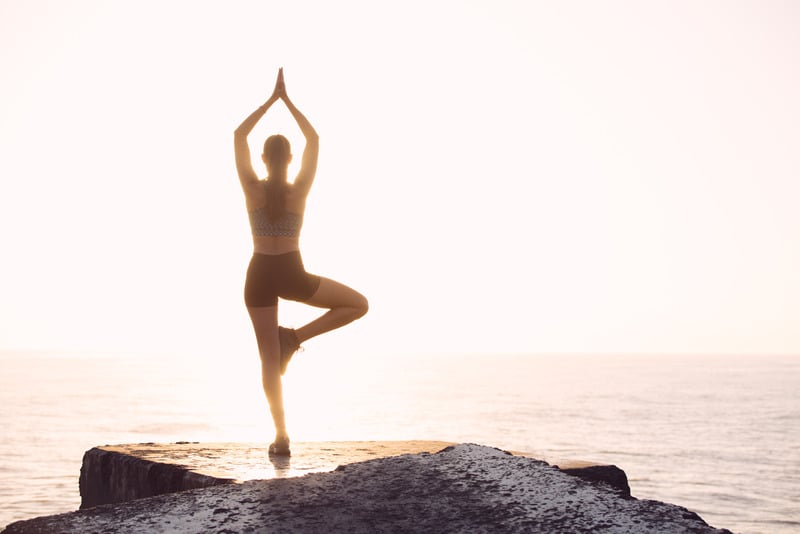
We get little commissions for purchases made through links in this post. Our editors carefully choose to promote only those products/services that resonate with our readers.
Yoga is an ancient Indian practice that builds the body, trains the mind, and evolves the spirit. It is a technique for the overall development of your mind, body, and soul.
There are several branches of yoga and traditional yoga has now been modified into a more modern form to suit the current lifestyle.
What is Yoga?
Yoga is considered to be an ancient form of physical exercise and fitness training involving different body parts. But it is much more than just a fitness regimen! It is a discipline involving specific postures for physical, mental, and spiritual wellbeing. Yoga practices originated in India and were mainly considered as a spiritual discipline.
Yoga has many forms and it was first introduced by the Hindus as can be understood from the Vedas and Upanishads. After that, yoga became popular among the Buddhists and the Jains. This ancient practice has been much modified since and it was introduced to the western world only recently!
Earlier one had to go to a guru to learn the forms of yoga but now you can learn it in a class from a trained yoga teacher.
TheMindFool Recommends
Yoga International lets you practice at home with the world’s top Yoga Teachers. Check them out!
The Eight Limbs of Yoga
Patanjali in his book, the Yoga Sutras classified yoga and declared that there lies an eightfold path to yoga. Simply put, there are 8 limbs of yoga practice.
1. Yama or Abstinences

Hinduism holds certain ethics or moral principles. These are called yama. Yama is the first limb of Ashtanga Yoga. The five Yamas as stated by Patanjali are – ahimsa or non-violence, satya or truthfulness, asteya or non-stealing, brahmacharya or chastity, and aparigraha or non-possessiveness.
2. Niyama or Observances

The second limb in Ashtanga Yoga are some virtuous habits mentioned in Patanjali’s Yoga Sutras. These habits are called niyama, such as – shaucha or purity, santosha or contentment, tapas or persistence, svadhyaya or studying and introspection, ishvara pranidhana or acknowledgment of the true self.
3. Asana or Postures
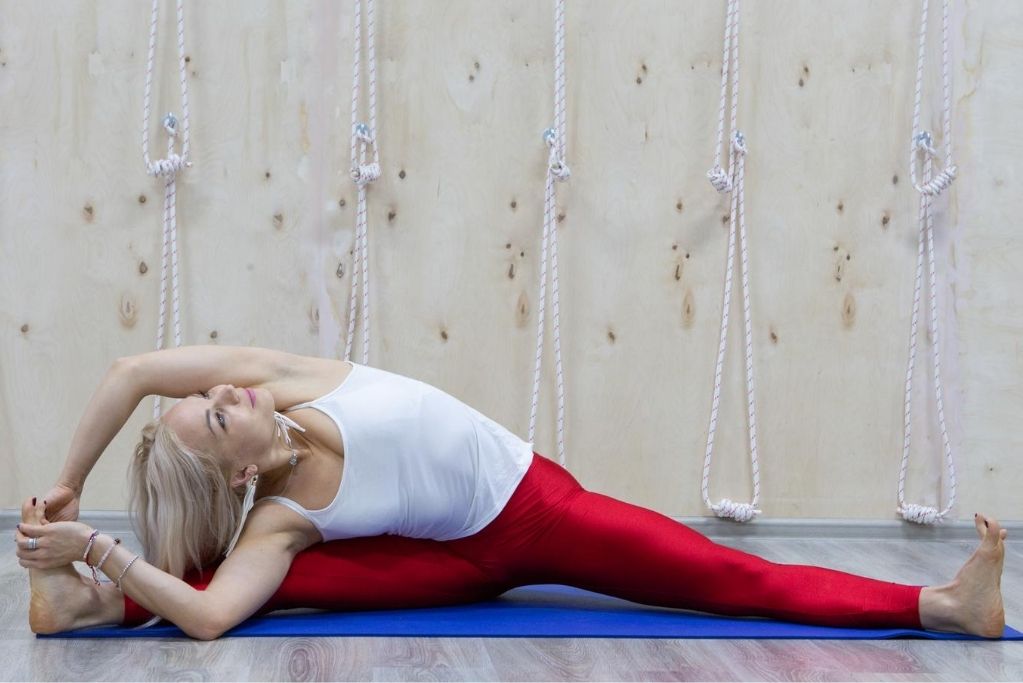
The third limb consists of the specific postures used in yoga practices called asanas. Asana is the physical practice that is mandatory if you want to learn yoga. There are many types of asanas and it is up to the yoga practitioner to choose a posture that is comfortable and effective for his/her yoga practices.
4. Pranayama or Breath control
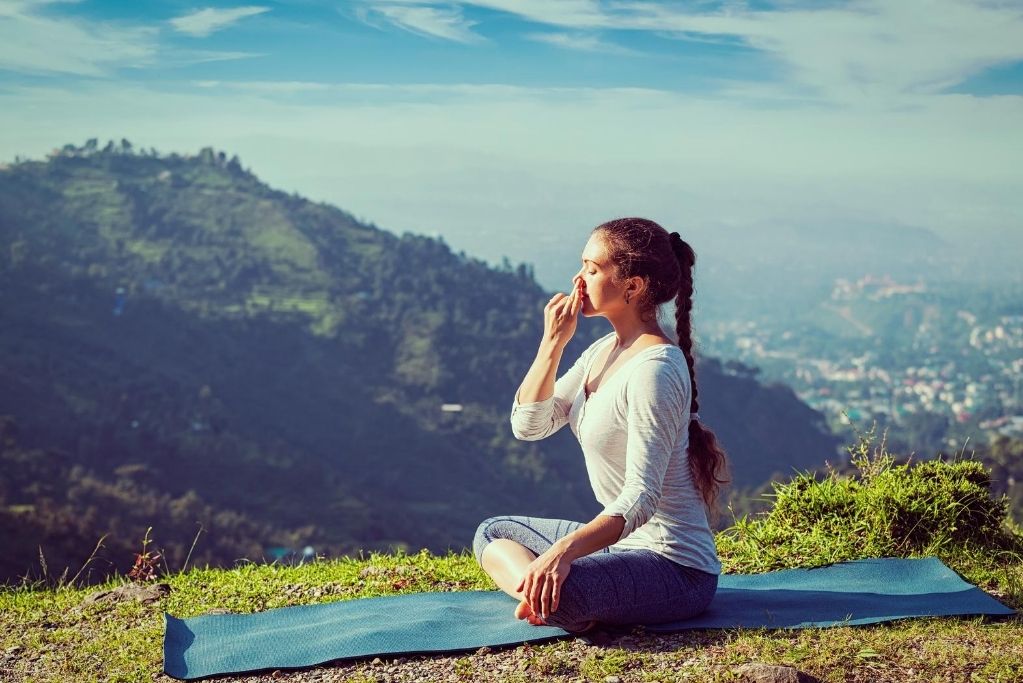
The fourth limb consists of techniques that gain mastery over our respiratory processes. Like asanas, pranayama is also extremely crucial for yoga practices. Pranayama is the conscious practice of breath regulation. It is said that illnesses occur due to faulty breathing.
In pranayama, you will learn how to inhale, hold the breath, and then exhale rightly. The timing and duration of your breaths matters.
5. Pratyahara or Withdrawal

The fifth limb of Ashtanga Yoga refers to pratyahara or withdrawal of the senses. In this stage, a yogi will consciously draw his awareness from the materialistic world and dive deep within. This practice gives the practitioner a chance to do self-reflection. In this stage you become self-observant.
TheMindFool Recommends
Looking for Yoga lifestyle garments and gear? Check Yoga Democracy – we love their designs!
The withdrawal stage helps to observe how you observe and react to the outside stimuli. You will identify habits that are interfering with your self-growth. Therefore, in pratyahara, a yogi can eliminate anything that is detrimental for his spiritual journey.
6. Dharana or Concentration

Now that a yogi has identified the external distractions and removed them, the next stage is to deal with the distractions within the mind itself. Therefore, in the sixth limb or Dharana, the yogi practices concentration. In this stage, he will learn how to slow down the thoughts by concentrating on a singular object.
This is considered as a pre-meditative stage. As your focus gets diverted you have to fine-tune your breathing technique or posture. Your ultimate goal is to bring your focus to a singular point. Ultimately, Dharana will lead to Dhyana.
7. Dhyana or Meditation
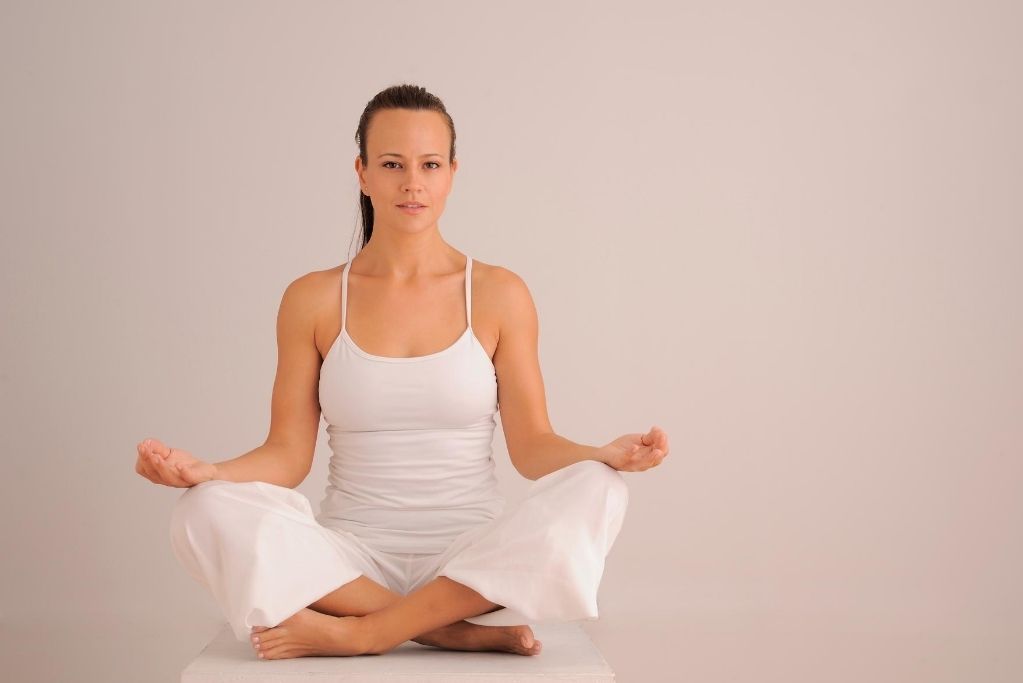
As a yogi practices Dharana for a longer period, he enters into the seventh limb of the Ashtanga Yoga. Dhyana or meditation is an uninterrupted flow of Dharana. Often, Dharana and dhyana are thought of as the same thing although there lies a fine difference between the two.
Dharana is the practice of concentrating on a singular object. Whereas, dhyana is a state of awareness without any focus. In dhyana, the mind becomes calm, still, and thoughtless. It takes a lot of practice and perseverance to attain a true state of dhyana.
8. Samadhi or Absorption

The eighth and final stage of Patanjali’s Yoga Sutras is the attainment of Samadhi. It is a state of yogic ecstasy in which the yogi merges with the divine power and spiritual enlightenment is said to occur.
This is the stage of bliss where the yogi realizes oneness with the Universe. Samadhi is the ultimate goal of yogis that helps them in attaining a truly peaceful state.
You may or may not reach the stage of Samadhi in this lifetime. It is said to be an indescribable state that can only be experienced through consistency, patience, and devotion.
These eight limbs are sequenced from the outer to our inner world. They are the gradual steps towards freeing our minds and becoming spiritually awakened. Asana or yoga postures are nowadays given more stress by yoga trainers but according to Patanjali, it is only one requirement out of the others.
History of Branches of Yoga
The history of yoga is uncertain because of the secretive mode of teachings by ancient Indian sages. There was also this system of orally communicating the important teachings rather than writing them in books. All this had made the principles of yoga damaged and to a large extent lost.
It has been estimated that yoga practices were prevalent about 5,000 years ago although some historians claim that Indian yoga can be about 10,000 years old.
In ancient India, yoga was compared to a living being – a tree with several branches! Each branch of yoga has its unique specialties. The branches of yoga have particular functions and they represent life and its forms.
Yoga and its branches can be traced back to be classified into four main periods.
1. Pre-Classical Yoga
Yoga is said to originate in Northern India about 5,000 years ago in the Indus- Sarasvati civilization. Yoga was developed by the sages and Brahmans and was first recorded in Rig Veda.
2. Classical Yoga
Classical yoga was established by Patanjali and he elaborated on the principles in Yoga Sutras. He prescribed an eight-limbed path of yoga.
3. Post-Classical Yoga
The Tantra Yoga was born a few centuries after the Yoga Sutras. The followers of this practice rejected traditional yoga practices and started bringing radical changes.
4. Modern Period
The modern period of yoga can be said to be initiated by Swami Vivekananda at the Parliament of Religions in Chicago in 1893. His lecture amazed the attendees and this was how the Indian yoga made an entrance to the western world.
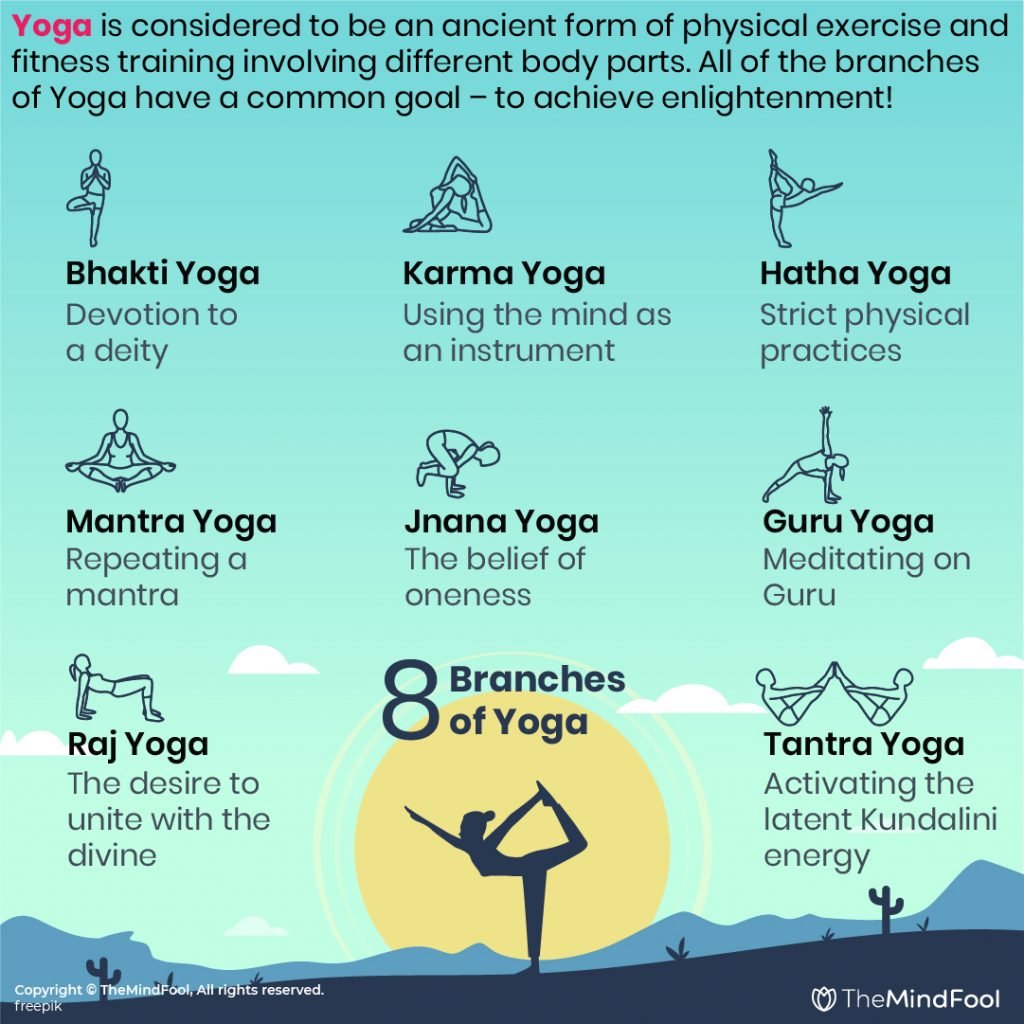
The Eight Branches of Yoga
There are mainly eight branches of yoga. All of these branches have a common goal – to achieve enlightenment! A particular branch could be more appealing to you than the others. However, one can experiment with multiple branches of yoga, and also these branches often overlap and collide with one another.
1. Bhakti Yoga
This form of yoga is often referred to as the yoga of devotion. It is based on the concept that we have arrived from divine power and we must deeply connect and eventually merge with it through our acts of devotion.
Bhakti Yoga is a spiritual practice in which the practitioner is devoted to worshiping a deity. It includes offering flowers, praising God, singing devotional hymns, and meditating on the supreme power.
2. Hatha Yoga
Hatha yoga is the yoga in which the practitioners will have to go through a series of physical techniques to raise the dormant kundalini energy at the base of their spine. In hatha yoga, the practitioner wants to achieve spiritual enlightenment using their body as an instrument instead of the mind.
The body is considered sacred and it is put in a strict regimen of yogic practice to attain enlightenment. Because the mind can easily be swayed away, some people believe that the strict practices of hatha yoga can take them to their spiritual path than any other form of yoga.
3. Karma Yoga
According to the Bhagwad Gita, karma yoga purifies the soul. This is called the yoga of action. Karma yoga is based on the spiritual practice of taking actions whether involving your body, through words or using the mind. It is a path of taking action without selfish desires, attachment, or expecting any outcome!
You are doing your own dharma or reaching a state where you are allowing God’s work to be done through you. The practitioner of Karma Yoga leads a life as being a medium of Lord Krishna taking all the rightful action towards spiritual awakening.
4. Mantra Yoga
Traditionally to do Mantra Yoga, an initiation is needed from a Guru or a teacher. Then you will receive a secret mantra from your Guru. You will have to repeat this mantra as often as directed by your Guru. This mantra has a specific sound that brings balance in your body and focuses on your mind.
As you chant the mantra along with the meditative practice you become calmer and connected to the Source energy.
Nowadays, Mantra Yoga is taught at yoga classes without any initiation. Even you are allowed to choose your mantra from words that bring you joy! Words such as “peace”, “success”, “love”, “happiness” etc. are often used.
5. Jnana Yoga
In Sanskrit Jnana means knowledge. It is referred to as the yoga of wisdom. Jnana Yoga has four steps –
Ø Viveka or discrimination
Ø Vairagya or Renunciation
Ø Shatsampatti or The Six Treasures
Ø Mumukshtva or Constant Striving for the divine
The main principle of the Jnana Yoga is that everything is one and the concept of duality is an illusion. Jnana yogis believe that the earthly pleasures are only distractions and they focus on their search for the divine.
6. Guru Yoga
In Sanskrit, Guru refers to the spiritual teacher or guide. A guru is an enlightened person or one who is close to his enlightenment. In Guru Yoga, you will meditate on your guru until you merge with him. In this form, Guru is the highest form of spiritual realization. The disciples or devotees must have a strong leap of faith towards their Guru.
7. Raja Yoga
Raja Yoga is the yoga that will lead you to spiritual enlightenment through Yama or discipline to samadhi or the state of intense concentration to unite with the divine. This yoga is called the ‘royal yoga’ and comes under the Classical Yoga of Patanjali’s Yoga Sutras. It needs an advanced level in yogic practice to be able to do raja yoga.
8. Tantra Yoga
This form of yoga is often referred to as the Kundalini Yoga because it activates the latent kundalini energy that is stored at the base of the spine. Tantra yoga is called the Yoga of continuity and it is misunderstood by many.
People have all the wrong notions about this form of yoga. It is said to include complicated postures and sexual practices. Although sexual rituals are used in certain schools of Tantra Yoga, it isn’t a common practice.
Tantra Yoga involves rituals and imagining the divine deities. The steps are often complex and need a lot of practice but this is indeed one of the most important forms of yoga.
Comparison Between The Eight Branches of Yoga
Bhakti Yoga – Based on devotion to a deity
Hatha Yoga – Based on strict physical practices
Karma Yoga – Based on using the mind as an instrument without attachment or expectations
Mantra Yoga – Based on repeating a mantra
Jnana Yoga – Based on the belief of oneness
Guru Yoga – Based on meditating on Guru
Raj Yoga – Based on the desire to unite with the divine
Tantra Yoga – Based on activating the latent Kundalini energy
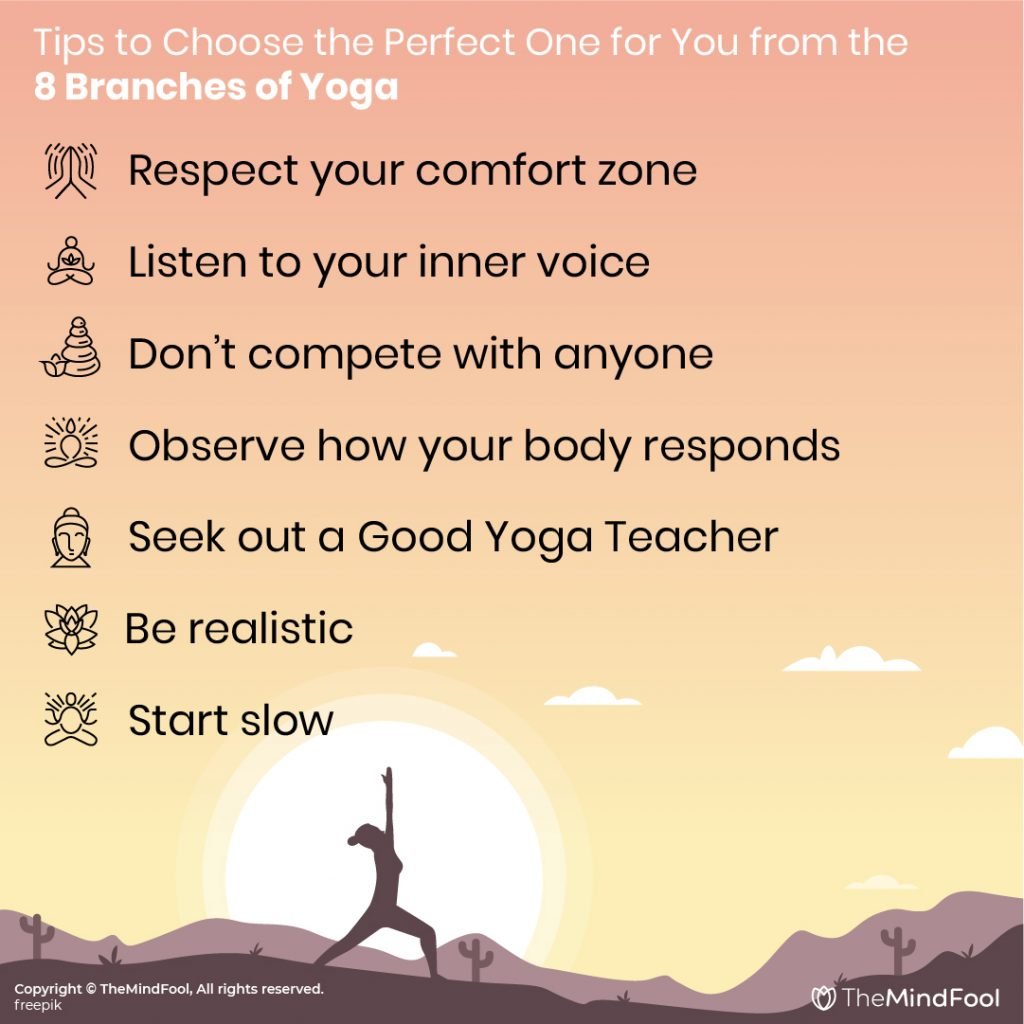
Tips To Choose The Perfect One for You from The 8 Branches of Yoga
1. Seek out a Good Yoga Teacher
The easiest way to choose the perfect form is through the guidance of your Yoga Teacher. No matter what everyone is doing, it might or might not be the right form of yoga for you! Therefore, it is important to seek out a good teacher.
The branches of Yoga are diverse and you have to understand which would be good for your mind, body, and soul. One way is to try all of the forms and then decide. But it might be overwhelming for beginners and confusing too! So, we can’t stress enough about finding an expert Yoga trainer.
2. Respect your comfort zone
After joining a class you might get excited and overdo the practices. This is really something to avoid! Know your body’s capacity and never strain it. Otherwise, you’ll subconsciously develop the idea that yoga is equivalent to pain!
Yoga is something that should make you feel good and not strained. Therefore, from day one of your practice, watch if you are comfortable doing the particular form of yoga. If not, talk with your trainer and change the yoga practice.
3. Listen to your inner voice
While choosing the proper form of Yoga for yourself, pay attention to your inner voice. After gaining some knowledge about the different branches of yoga, you might be naturally inclined to a particular form. Seek inner guidance.
4. Be realistic
To correctly choose your yoga form, be practical. How much time can you actually give to it? If you are extremely busy or so many things are happening in your life presently, it’s advisable to select a yoga that is simple.
Unrealistic expectations can lead to frustration and you most probably can quit it totally! Therefore, select a form that would suit your lifestyle.
5. Don’t compete with anyone
Yoga is a path of transformation. It provides unique experiences and realizations. Besides that, each and every branch of yoga has the same goal. The main objective of each of the forms of yoga is self-awareness which eventually would lead to spiritual awakening.
Yoga is not for competition. Nobody is better or worse, they are just at different levels of the practice. If you join a Yoga Class today and start comparing with the practitioners who are doing it for a long time you will just frustrate yourself. Stop comparing or competing with others.
Through yoga practices, you will walk your own path and have your own experiences. So, relax and enjoy the ride! Don’t let other people’s success make you feel low. And please stop comparing your yoga postures with others. Initially, they would not be perfect. You will also reach there. Not today, but eventually!
6. Observe how your body responds
It is extremely important to observe your body after having started the yoga practice. Do you now feel more energetic? Are you having better sleep? Do you feel fit and happy? The right yoga practice will only make your body feel great!
So, watch how your body is responding. Is it getting rid of those headaches or you are more fatigued nowadays? The yoga that is best suited for you will only make your body more sound and fit.
7. Start slow
Better start the yoga classes and go slow. No need to rush, no need to search for the benefits, just breathe and let go! Things get better when you give time to it.
So, do your yoga consistently and hold the belief that it will slowly bring the changes that you want to see. You don’t have to become an expert. Just do it step by step on a daily basis. Follow the instructions and enjoy the process.
Also, do not try experimenting on different approaches at a time! Start with one, stick to it until it gets good then if you want, try another form.
TIP
When you have chosen a branch of yoga that’s suitable for you, start applying the principle of Seva or selfless service to gain more benefit! Seva is the act of service to humans, animals, or the world in general without any expectation.
When Seva is practiced along with yoga it gives the maximum benefit. This is because its effects will lead to your spiritual transformation. Seva clears your consciousness and leads to spiritual liberation.
Closing Thoughts
Yoga is an ancient practice to benefit the body and mind. It originated in India and there are mainly eight branches of yoga. Yoga has evolved over the years and now it is taught at Yoga Classes by trainers who help you choose a form that’s best for you.
The main goal of each of these branches of yoga is the same – to connect with the divine and allow spiritual awakening.
Ishita is a published author, poet and freelance writer. Being an avid reader from early childhood, she has always loved books more than anything else in the world! At the start of her career, she has worked in the corporate as well as the academic sector being a double master's degree holder - M.Sc and MBA. But now she is a fulltime writer. She believes words have immense power and writers can make a huge impact in the world! She wants to bring positivity into the lives of the readers through her association with TheMindFool.
